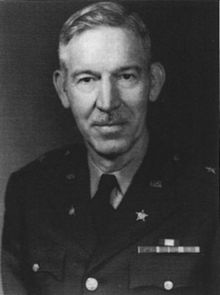Herbert Loper
| Herbert Bernard Loper | |
|---|---|

Major General Herbert B. Loper
|
|
| Born | 22 October 1896 Kansas |
| Died | 25 August 1989 (aged 92) Palm Bay, Florida |
| Allegiance |
|
| Service/branch |
|
| Years of service | 1918–1955 |
| Rank |
|
| Commands held | Armed Forces Special Weapons Project |
| Battles/wars | |
| Awards |
Distinguished Service Medal Legion of Merit (2) |
| Other work | Chairman of the Military Liaison Committee |
Herbert Bernard Loper (22 October 1896 – 25 August 1989) was a United States Army major general who helped plan the Mariana and Palau Islands campaign and the Okinawa campaign during World War II. He was chief of the Armed Forces Special Weapons Project from 1952 to 1953, and Chairman of the Military Liaison Committee of the United States Atomic Energy Commission from 1954 to 1961.
A graduate of the United States Military Academy at West Point, he was commissioned in the US Army Corps of Engineers in 1919. He graduated from the United States Army Command and General Staff College at Fort Leavenworth, Kansas in 1940, and became Assistant Chief, and later Chief, of the Intelligence Division at the Office of the Chief of Engineers in Washington, DC. In May 1942, he negotiated the Loper-Hotline Agreement, under which responsibility for military mapping and survey of the globe was divided between the United States and the United Kingdom. In 1944, he was appointed Chief Engineer of US Army Forces, Pacific Ocean Areas. In this role he was involved with the planning of the Mariana and Palau Islands campaign and the Okinawa campaign. After the fighting ended, he participated in the Occupation of Japan.
Loper returned to the United States to become Chief of the Joint Photo and Survey Section of the Joint Chiefs of Staff's Joint Intelligence Group in 1948. The next year he was appointed as an Army member of the Military Liaison Committee of the United States Atomic Energy Commission. He wrote a report which became known as the Loper Memorandum, which was influential in the decision to develop thermonuclear weapons. He was Deputy Commander of Joint Task Force 3, which was responsible for the conduct the Operation Greenhouse nuclear tests in the Pacific. In 1951 became Chief of the Armed Forces Special Weapons Project, but was forced to retire after he suffered a heart attack in 1953. He subsequently served as Chairman of the Military Liaison Committee from 2 August 1954 to 14 July 1961.
...
Wikipedia
